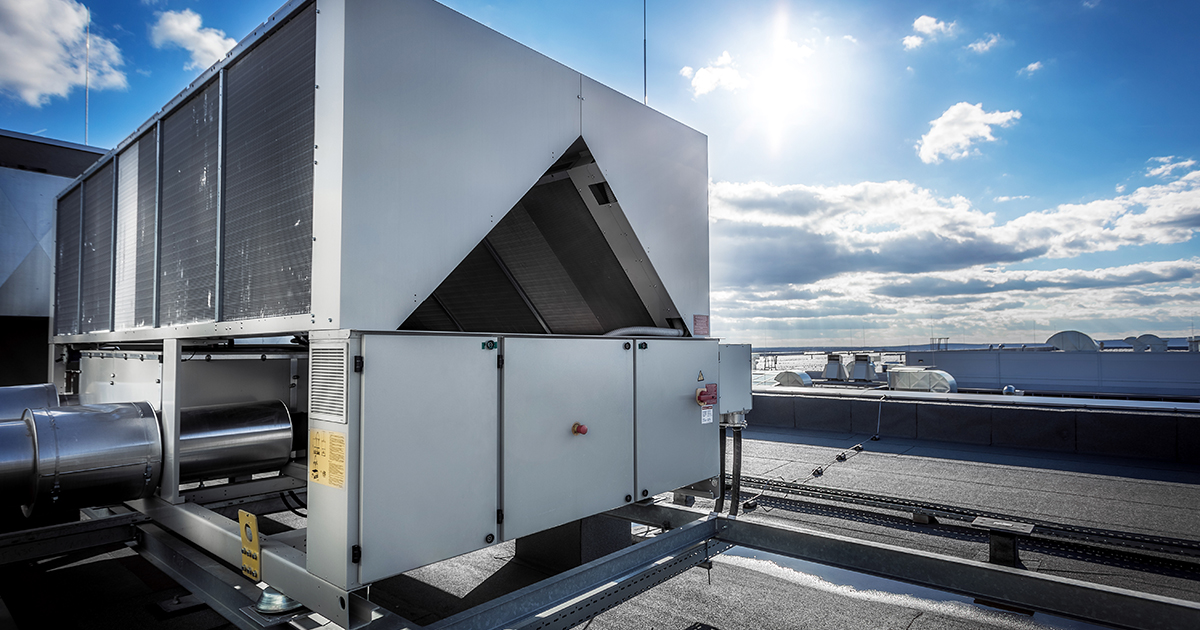
Advancing the electrification of RTUs in the Commercial and Industrial market
Packaged rooftop units, or RTUs, make up around 40% of the commercial and industrial market, where everything from office buildings to hospitals to warehouses rely on RTUs to heat and cool their spaces. Within that large market, standard gas-fired RTUs comprise the vast majority of total RTUs, with electric-resistance, heat-pump, and dual-fuel RTUs making up the remaining units.
That's a lot of potential for electrification. But what are the barriers keeping energy efficiency programs from tapping into this market?
| Types of RTUs, sorted by increasing potential for decarbonization | ||
|---|---|---|
| Type of RTU | Cooling method | Heating method |
| Gas-fired RTU | Direct expansion | Natural gas |
| Electric resistance RTU | Direct expansion | Electric resistance |
| Dual-fuel RTU | Heat pump | Heat pump, with a natural gas heat exchanger for backup |
| Heat pump RTU | Heat pump | Heat pump, with electric resistance for backup |
Slipstream recently conducted a market research study for a state energy efficiency agency in the northeast. We wanted to identify the barriers that are most responsible for keeping building owners from adopting heat pump RTUs or dual-fuel RTUs in place of standard gas-fired RTUs.
We interviewed stakeholders including manufacturers, distributors, contractors, design firms, energy consulting firms, and end users. Our study looked at both retrofit and new construction applications.
What we found: Barriers to RTU electrification
Municipal carbon goals and building performance standards drive electrification for new construction.
Some building owners will independently pursue electrification, but most need a little push. When cities set carbon goals—and, crucially, set financial penalties for incompliance—it motivates building owners and design teams to electrify their RTUs.
Likewise, organizations with overarching carbon reduction goals tend to prioritize the benefits of heat pump RTUs over barriers such as costs.
We found that many design engineers recommend heat pump RTUs for new construction specifically to comply with building performance standards or ESG goals.
Equipment availability is a major concern for retrofits.
In the market we surveyed, local distributors and manufacturers didn't typically stock heat-pump and duel-fuel RTUs—at least not at the scale we'd need to meet the demand for retrofits. Building owners faced long lead times for equipment compared to gas-fired RTUs, and only half the brands we identified offered dual-fuel RTU as an option.
These long lead times particularly affect small business owners in the replacement market, who often need the equipment quickly. Universities and large corporations tend to have a planned replacement model, which allows for longer timelines.
Either way, upfront cost is still a major barrier.
In our survey, heat pump and dual-fuel RTUs could cost anywhere from 15 to 50% higher than gas-fired RTUs. The cost for labor didn't vary as widely, but some contractors charged a premium for retrofits that weren't like-for-like replacements.
The upfront cost is even greater when retrofits require changes in structure and/or space. When converting gas-fired RTUs to heat pump RTUs, building owners might have to consider questions such as:
- Will the expanded heating capacity increase the unit's footprint?
- Will I need upgrade my electrical service?
- Will I need to change the existing curb?
These cases might make dual-fuel RTUs an ideal option, as these units can avoid many of these structural changes, thereby reducing upfront cost.
Building owners see too many risks with heat pump RTUs.
In our study, some stakeholders indicated that a utility incentive that only covers the incremental equipment cost may not be enough to push customers to adopt heat pump or dual-fuel RTUs.
With any new technology comes more perceived risks—even if those fears are unfounded.
Fear: If we cover the upfront cost of a dual-fuel RTU, it won't make up for the increased electrical bills.
Reality: Even in this northeastern market with high electricity costs, our modeling results showed that an efficient dual-fuel RTU can save up to 20-30% over an existing gas-fired RTU.
Fear: If we convert to a heat pump RTUs, we might not keep the building warm enough in winter.
Reality: It's a misconception that heat pumps aren't effective in cold climates. Educational campaigns and more case studies should help ease these concerns.
Recommendations to expand the market for heat pump RTUs
Increase education and awareness for design engineers, contractors, and end users. Programs should also increase technical support to account for decisions that may veer from the typical one-to-one replacement – especially as designers and contractors get used to the new technology.
Policies to promote electrification, including building performance standards, are a good incentive, especially for new construction projects.
Engage the supply lines – partner with local distributors and manufacturer representatives to increase supply. As with the market for residential air-source heat pumps, manufacturers and distributors play a key role in meeting demand.
There's a bit of a chicken-and-the-egg scenario here: manufacturers and distributors might not see much demand for heat pump RTUs currently, but that demand is deflated in part because of the short supply. Programs should engage supply chain actors to promote and stock these products, and work with manufacturers directly to expand capacity and product lines.
Encourage large institutions with long-term planning timelines – such as universities or corporations with ambitious carbon-reduction goals – to adopt heat pump RTUs now.
Counter misconceptions with more evidence and well-designed incentives. Fund field demonstrations and research to dispel skepticism of heat pump RTUs in cold climates.
Design and streamline utility incentives. Incentives shouldn't just cover the incremental cost of equipment – they should also account for additional costs of potential structural upgrades.
One way to streamline incentives might be to encourage a full decarbonization package that combines heat pump RTUs with integrated building technologies, including energy recovery ventilators, demand management to cover winter peaks, and distributed energy resources such as onsite solar PVs.